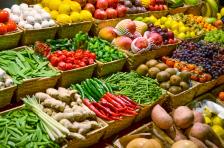Getting More Nutrition from Vegetables
To increase the nutritional value of vegetables, add some fat.
Monica Reinagel, M.S.,L.D./N
Listen
Getting More Nutrition from Vegetables

But you’ll actually get more nutrition out of those vegetables if you eat them with a little fat. That’s because many of the most valuable nutrients in vegetables are what we call fat-soluble (or lipid-soluble) vitamins. These include vitamin A, which protects your eyesight, vitamin K, which builds healthy bones and keeps your heart healthy, as well as beta carotene, lycopene, and all the carotenoids, which fight free radicals and ward off cancer.
Why Some Fat Is Good
These nutrients don’t contain any fat themselves. But in order to be absorbed into your cells, where they can do you some good, they need to hitch a ride on a fat molecule.
Isn’t this the greatest news you’ve gotten all day? Eating your spinach sauteed in a bit of olive oil and garlic or dipping your carrot sticks in peanut butter is actually much better for you than eating them plain. A study published in the Journal of Nutrition reported that when researchers added avocado to a salad, the subjects absorbed up to 15 times more fat-soluble nutrients than those who ate the plain salad. (Now that’s the sort of medical research I want to do: the kind that involves guacamole!)
Choose Healthy Fats
Although any type of fat will make fat-soluble vitamins more absorbable, it’s best to go with healthy fats, like those found in olives, olive oil, nuts, nut oils, and avocados, instead of saturated fats like those found in cheese and butter.
And, of course, you don’t want to overdo it, especially if you’re watching your weight. Calories from fats–even healthy fats–can add up quickly. If you’re not careful, you can turn a healthy, low-calorie meal or snack into a real diet-buster. In terms of nutrient absorption, it only takes a little bit of fat to get the job done. A couple tablespoons of guacamole or peanut butter with your raw vegetable snack, or a couple teaspoons of olive oil on your salad or cooked greens is all you need.
Quick and dirty tip: The fat and the vegetables also don’t have to be on your fork at the same time. If anything else that you’re eating in the same meal contains some fat, you’re already covered. If not, pass the guacamole!
Be sure to check out my Quick Tip for washing fruits and vegetables over here. I’ve also got a handy little tip on getting more nutrition from your cooked vegetables.
This is Monica Reinagel, the Nutrition Diva, with your quick and dirty tips for eating well and feeling fabulous. Visit nutritiondiva.quickanddirtytips.com for a transcript of this episode, along with a link to the journal study I mentioned. If you have a nutrition question for me, send an e-mail to nutrition@quickanddirtytips.com. You can follow me on Facebook. Or, send me a tweet on Twitter! You’ll find me at twitter.com/nutritiondiva.
RESOURCES
